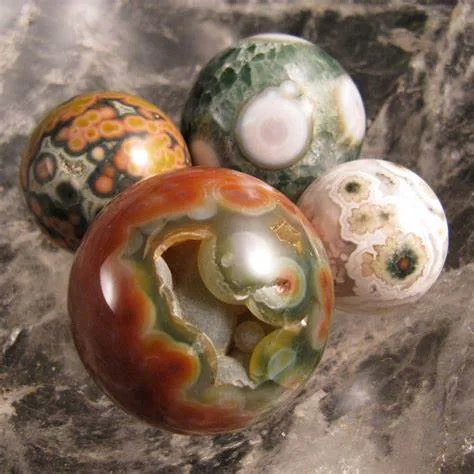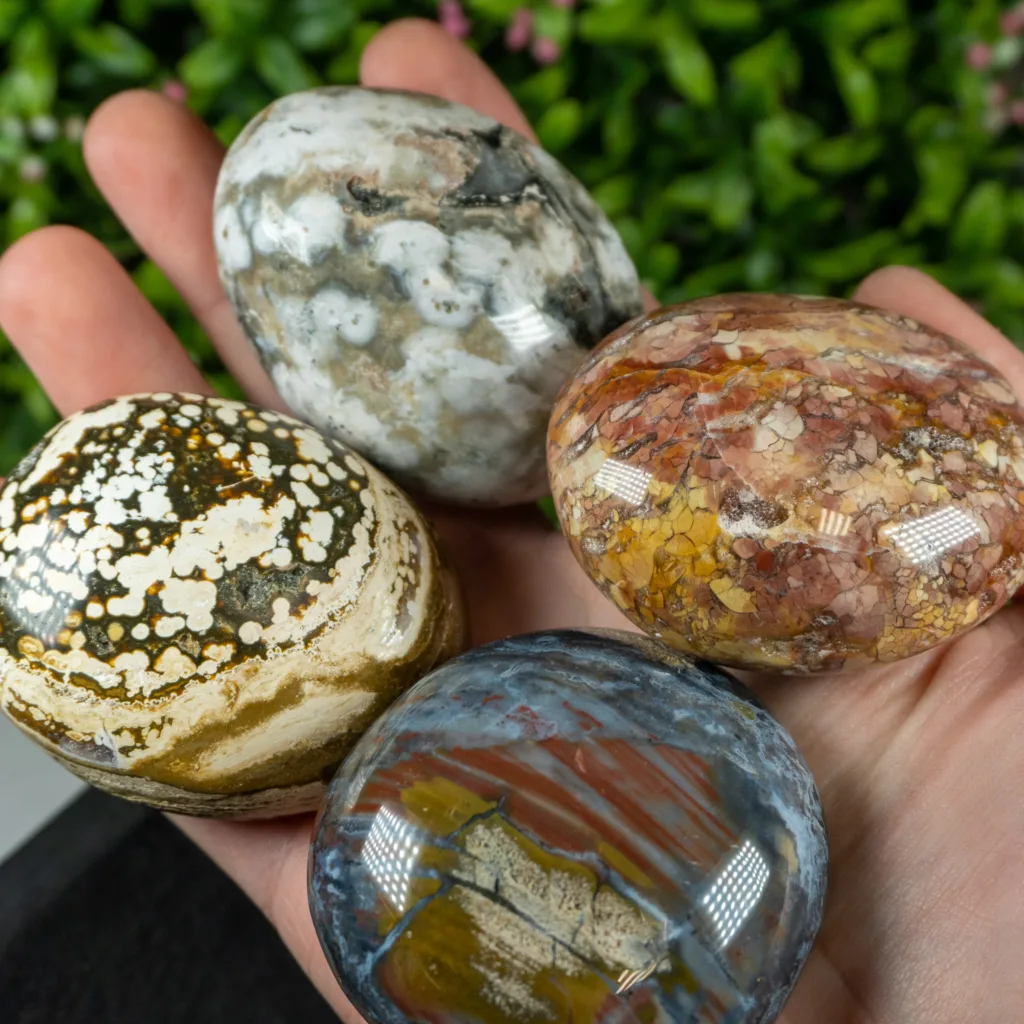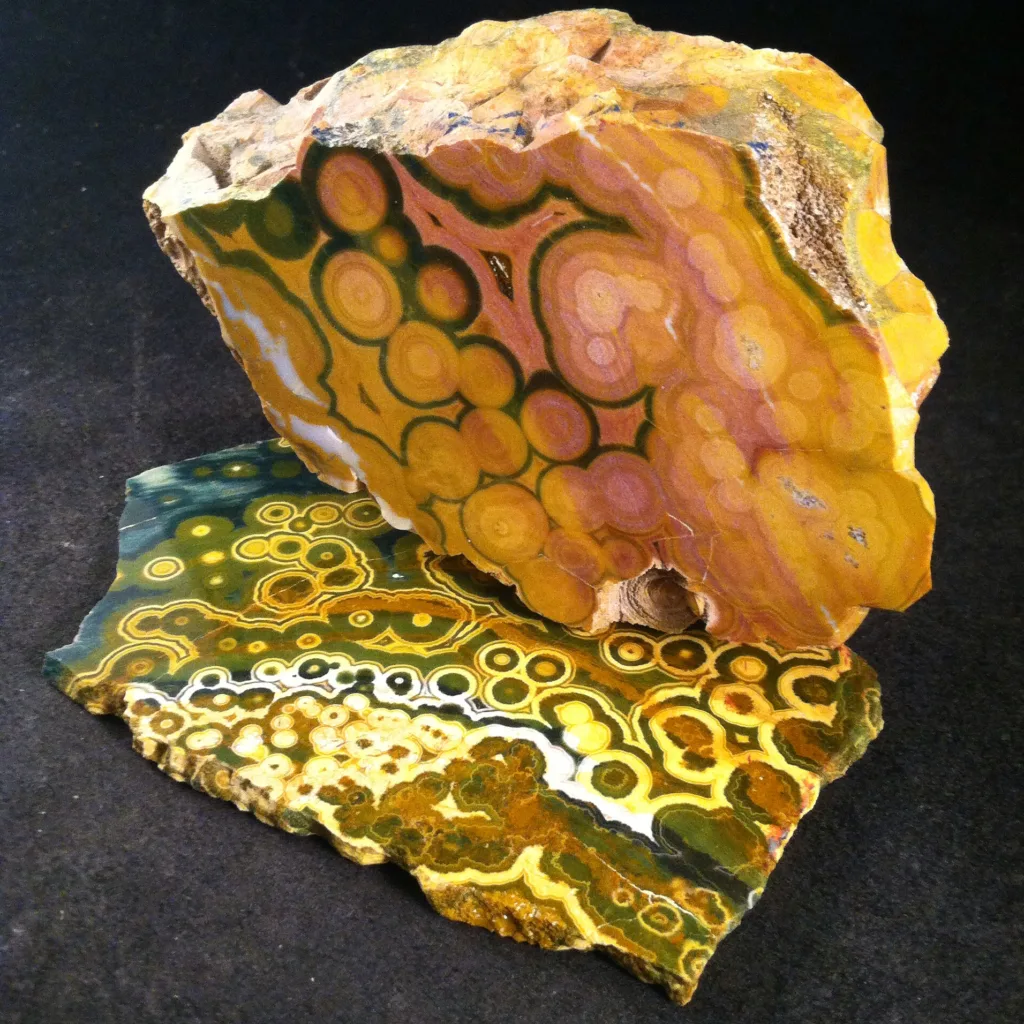Ocean Jasper is a type of semi-precious gemstone and mineral that is known for its vibrant and intricate orbicular patterns and colors. It is a variety of chalcedony, which is a type of microcrystalline quartz. Ocean Jasper is specifically found in only one location in the world, the coast of Madagascar, near the small village of Marovato. This limited geographical occurrence adds to its rarity and desirability among collectors and enthusiasts.

Appearance: Ocean Jasper is characterized by its striking, spherical patterns, often resembling the appearance of orbs or circles. These orbs come in various colors and combinations, including shades of green, pink, red, yellow, and white. The background color of the stone can be green, blue, or white.
Variability: One of the most fascinating aspects of Ocean Jasper is its variability. No two pieces are identical, making each stone unique. The patterns and colors within the orbs can vary significantly from one piece to another.
Origin: As mentioned, Ocean Jasper is primarily found along the coast of Madagascar. The gemstone is often mined in remote areas accessible only by boat, which can make its procurement challenging.
Metaphysical Properties: Like many gemstones, Ocean Jasper is associated with various metaphysical and healing properties in alternative and holistic practices. It is often considered a stone of relaxation and cooperation, believed to help with stress reduction and promoting a sense of tranquility.
Use in Jewelry: Ocean Jasper is a popular choice for lapidaries and jewelry designers due to its unique and eye-catching patterns. It is typically cut into cabochons, beads, and other polished forms for use in jewelry, such as pendants, rings, and earrings.
Collectibility: Due to its limited source and distinctive appearance, Ocean Jasper is highly sought after by mineral and gemstone collectors. Specimens with exceptional patterns and colors can command high prices in the market.
Environmental Considerations: The mining of Ocean Jasper has raised environmental concerns, as the only known deposit is in a sensitive coastal area of Madagascar. Ethical sourcing and responsible mining practices are important considerations when dealing with this gemstone.
In summary, Ocean Jasper is a captivating and rare gemstone known for its unique, orbicular patterns and a wide range of vibrant colors. Its limited source in Madagascar and distinctive appearance make it a popular choice for collectors and jewelry enthusiasts, though ethical sourcing and environmental considerations are important factors to be aware of when working with this beautiful stone.
Contents
Geographic Origin

Ocean Jasper is found exclusively on the coast of Madagascar, an island nation located off the southeastern coast of Africa in the Indian Ocean. Specifically, it is primarily mined near the small village of Marovato, which is situated in the northeastern part of the island. The deposit is often referred to as the “Ocean Jasper mine.” This single source location is the only known place in the world where Ocean Jasper is found, adding to its rarity and desirability.
Geological Formation:
Ocean Jasper is a variety of chalcedony, which itself is a microcrystalline form of quartz. Its unique orbicular patterns and vibrant colors are the result of a combination of geological processes. The exact formation of Ocean Jasper is still a subject of scientific study and debate, but some theories suggest the following processes:
- Silicification: Ocean Jasper, like other chalcedonies, is formed through the process of silicification. This involves the replacement of other minerals with silica (primarily quartz). Over time, the replacement of the original material by silica results in the formation of chalcedony.
- Mineral Solutions: The colorful orbs or circles in Ocean Jasper are believed to be the result of variations in the composition of mineral-rich solutions that permeate the host rock. These solutions may contain elements like iron, manganese, and other impurities that contribute to the distinctive colors and patterns.
- Volcanic Activity: The geological history of Madagascar is characterized by volcanic activity, which has played a significant role in the formation of various minerals, including Ocean Jasper. Some theories suggest that Ocean Jasper’s formation may be associated with hydrothermal activity related to volcanic processes.
- Post-Depositional Processes: After the initial formation, secondary processes like erosion and chemical alteration likely played a role in shaping the unique patterns and colors seen in Ocean Jasper.
The specific combination of these geological factors, along with the presence of various impurities, gives rise to the remarkable and diverse patterns that make Ocean Jasper so highly prized among collectors and enthusiasts. The orbs and swirls of color are believed to be a result of concentric layers of chalcedony forming within voids or cavities in the host rock, and the exact appearance of Ocean Jasper can vary widely from one piece to another due to these complex geological processes.
Characteristics of Ocean Jasper

Ocean Jasper is a distinctive and highly sought-after gemstone known for its unique characteristics, which contribute to its beauty and appeal. Here are some of the key characteristics of Ocean Jasper:
- Orbicular Patterns: The most defining feature of Ocean Jasper is its striking orbicular patterns, which appear as rounded, concentric circles or orbs. These patterns can range from tiny specks to large, eye-catching circles, and they come in various colors, such as green, pink, red, yellow, and white. The orbs are often set against a background color of green, blue, or white, creating a mesmerizing visual effect.
- Color Variability: Ocean Jasper exhibits a wide range of colors and combinations. The hues in the orbs can vary from piece to piece, making each specimen unique. This range of colors and patterns has led to the gemstone being used in diverse types of jewelry and art.
- Translucency and Luster: Ocean Jasper typically has a translucent to opaque appearance, depending on the specific piece. When polished, it can display a waxy to vitreous luster, adding to its visual appeal.
- Smooth Texture: When properly polished, Ocean Jasper has a smooth, tactile texture that feels pleasant to the touch. This quality makes it popular for use in jewelry, especially for cabochons and beads.
- Rarity: Ocean Jasper is rare and primarily found in one location in the world, the coast of Madagascar. This limited source contributes to its desirability among collectors and jewelry enthusiasts.
- Geometric and Organic Shapes: While it is typically fashioned into polished cabochons and beads for jewelry, it can also be found in natural, uncut forms with irregular shapes, which add to its artistic value.
- Unique Inclusions and Impurities: The patterns and colors of Ocean Jasper are often influenced by the presence of various inclusions and impurities, including minerals like hematite, goethite, and other elements. These inclusions contribute to the gem’s distinct visual character.
- Metaphysical Properties: In addition to its aesthetic appeal, it is believed to have metaphysical and healing properties in alternative and holistic practices. It is often associated with relaxation, stress reduction, and harmony.
- Environmental Considerations: Due to the sensitivity of the mining location in Madagascar, ethical sourcing and responsible mining practices are important factors to consider when dealing with Ocean Jasper.
- Collectibility: Ocean Jasper is highly collectible, and specimens with exceptional patterns, colors, and orbs are particularly prized among collectors and lapidary enthusiasts.
In summary, It is a captivating gemstone known for its one-of-a-kind orbicular patterns and a wide range of vibrant colors. Its rarity, variability, and aesthetic appeal make it a highly desirable gem for both collectors and jewelry designers.
Mining and Sources of Ocean Jasper

Ocean Jasper is exclusively found in a single location in the world, along the coast of Madagascar, near the small village of Marovato. Here’s an overview of the mining and sources of Ocean Jasper:
- Location: The primary source of Ocean Jasper is a remote area in the Ambolobozo Peninsula in northwestern Madagascar. The gemstone is found in the form of nodules or rounded masses within volcanic rocks.
- Mining: It is typically mined from the host rock in the form of nodules. These nodules can be quite large, and they are often extracted using hand tools and sometimes dynamite to break them free from the surrounding rock. Mining Ocean Jasper is a labor-intensive process, and it often requires navigating difficult terrain, as access to the mining sites is often by boat.
- Environmental Considerations: The limited source and the environmental sensitivity of the mining location have raised ethical and environmental concerns. The Ambolobozo Peninsula contains unique and delicate ecosystems, and overzealous or irresponsible mining practices could harm the environment. As a result, there is a growing awareness of the need for responsible mining and ethical sourcing of Ocean Jasper.
- Lapidary and Processing: Once the nodules are extracted, they are typically transported to cutting and lapidary workshops where skilled artisans cut and shape the Ocean Jasper into various forms, including polished cabochons, beads, and other jewelry components. The lapidaries aim to showcase the gem’s unique orbicular patterns and vibrant colors.
- Distribution: After processing, It is distributed to various markets, both domestically in Madagascar and internationally. It is especially popular among lapidary artists, jewelry designers, collectors, and metaphysical practitioners.
- Market Availability: Due to its limited source and growing popularity, it can sometimes be challenging to obtain in the market. High-quality, beautifully patterned specimens are particularly sought after and can command premium prices.
- Ethical Sourcing: In response to environmental concerns and the need for responsible sourcing, some efforts have been made to ensure ethical and sustainable mining practices. These initiatives aim to minimize the environmental impact of mining and promote the well-being of local communities.
As with any precious or semi-precious gemstone, it is important for consumers, collectors, and jewelry designers to be aware of the source and origin of Ocean Jasper and to support ethical practices within the industry. Responsible sourcing and environmentally conscious mining are essential considerations when dealing with this unique and highly desirable gemstone.
Types and Varieties

Ocean Jasper is a distinct variety of chalcedony known for its unique orbicular patterns and a wide range of colors. While there isn’t a strict classification system for different types or varieties of Ocean Jasper, the gemstone can exhibit a considerable degree of variation in its patterns and colors. The primary distinguishing features of Ocean Jasper are the orb patterns, background color, and orb colors. These variations result in a range of visual effects and aesthetics. Here are some of the types and varieties based on these features:
- Orb Color Varieties:
- Green Ocean Jasper: Characterized by green orbs set against a background that can range from white to various shades of green. It is one of the most common and widely recognized types of Ocean Jasper.
- Red Ocean Jasper: Features red or rust-colored orbs on a contrasting background, typically in shades of white or green.
- Yellow Ocean Jasper: Displays yellow orbs with backgrounds that can vary in color, often green or white.
- Pink Ocean Jasper: Pink orbs set against backgrounds that may include shades of white, green, or pink.
- Orb Pattern Varieties:
- Classic Ocean Jasper: This variety exhibits well-defined, concentric orb patterns, and it is the most commonly recognized form of Ocean Jasper.
- Orbless Ocean Jasper: Some pieces may lack clear orb patterns and appear more mottled or without the typical orbs. These are often considered a unique variety.
- Scenic Ocean Jasper: Scenic Ocean Jasper features landscape-like patterns that can resemble natural scenes, such as forests or seascapes. These pieces are highly prized for their artistic and storytelling qualities.
- Background Color Varieties:
- Green Background Ocean Jasper: The background color of it can range from pale green to deep forest green, providing a different overall appearance to the gemstone.
- Blue Background Ocean Jasper: Though less common, some Ocean Jasper specimens have blue backgrounds, creating a distinct and appealing color contrast.
- Mixed Varieties:
- Rainbow Ocean Jasper: This variety incorporates a mix of various orb colors, resulting in a rainbow-like appearance. The orbs can feature a combination of green, pink, red, yellow, and other colors.
- Ocean Jasper Banded Agate: Occasionally, It is found in combination with agate bands, creating a banded appearance in addition to its orbicular patterns.
- Geographical Varieties: Some enthusiasts may classify Ocean Jasper based on the specific location within the mining area, as different areas can produce stones with unique characteristics.
It’s important to note that these “varieties” are often not officially recognized categories but rather informal descriptions used by collectors, lapidaries, and enthusiasts to differentiate between different visual appearances of Ocean Jasper. The gem’s rarity, variable patterns, and colors make it an appealing and collectible material, and the diversity of its visual characteristics adds to its allure.
Uses and Applications of Ocean Jasper

Ocean Jasper, with its unique beauty and aesthetic appeal, finds a variety of uses and applications, primarily in the realms of jewelry and lapidary arts. Here are some of the common uses and applications of Ocean Jasper:
- Jewelry: It is a popular choice for jewelry designers and enthusiasts due to its striking patterns and vibrant colors. It is often cut into cabochons, beads, and pendants. Common jewelry items include rings, earrings, necklaces, bracelets, and brooches.
- Lapidary Art: Lapidaries and artisans appreciate Ocean Jasper for its distinctive patterns and translucency. They use it to create carved sculptures, decorative objects, and lapidary art pieces, showcasing the gem’s unique features.
- Collector’s Specimens: Ocean Jasper’s rarity and the diversity of its patterns make it highly sought after by mineral and gemstone collectors. Collectors often seek specimens with exceptional orbicular patterns and vibrant colors.
- Metaphysical and Healing Practices: In the realm of metaphysical and holistic healing, Ocean Jasper is believed to possess calming and balancing properties. It is thought to help with relaxation, stress reduction, and emotional harmony. As such, it may be used in energy work, crystal grids, or as a meditation aid.
- Home Decor: Polished Ocean Jasper pieces are sometimes incorporated into interior decor, offering a touch of natural beauty and serenity to spaces. They can be used as decorative stones, paperweights, or incorporated into various art forms.
- Art and Craft Projects: Artists and crafters use Ocean Jasper in various artistic and craft projects, such as mosaics, collage, and mixed-media art. Its unique colors and patterns can add visual interest to art creations.
- Gift Items: Ocean Jasper jewelry and polished specimens make excellent gift items for individuals who appreciate gemstones and unique natural materials.
- Educational and Geological Study: It is used in educational settings and geological studies to illustrate the formation of chalcedony and the influence of geological processes on mineral patterns and colors.
- Spiritual and Meditation Tools: It is sometimes used as a meditation aid or as a tool in spiritual practices. Its calming qualities are believed to facilitate relaxation and enhance the meditative experience.
- Resale and Collectibles Market: Given its limited source and growing popularity, it can be an investment for those who acquire high-quality specimens and anticipate their value increasing over time.
It’s important to note that while it is a versatile and beautiful gemstone, it should be cared for properly, as it is not as hard as some other gemstones like diamonds. Protecting it from scratches and avoiding exposure to harsh chemicals is essential to preserve its appearance and value. Additionally, when purchasing Ocean Jasper, consider its ethical sourcing and origin to ensure responsible and sustainable practices in the gemstone trade.




































